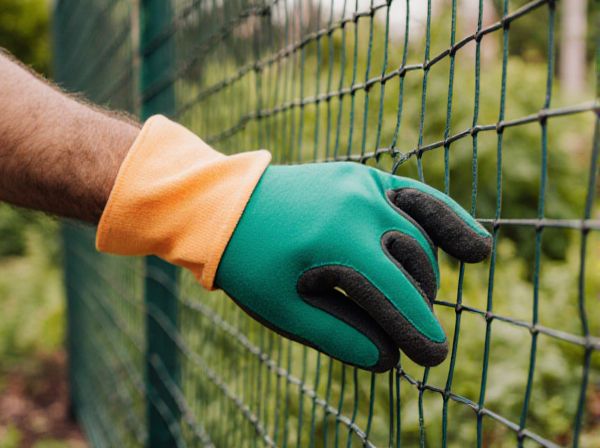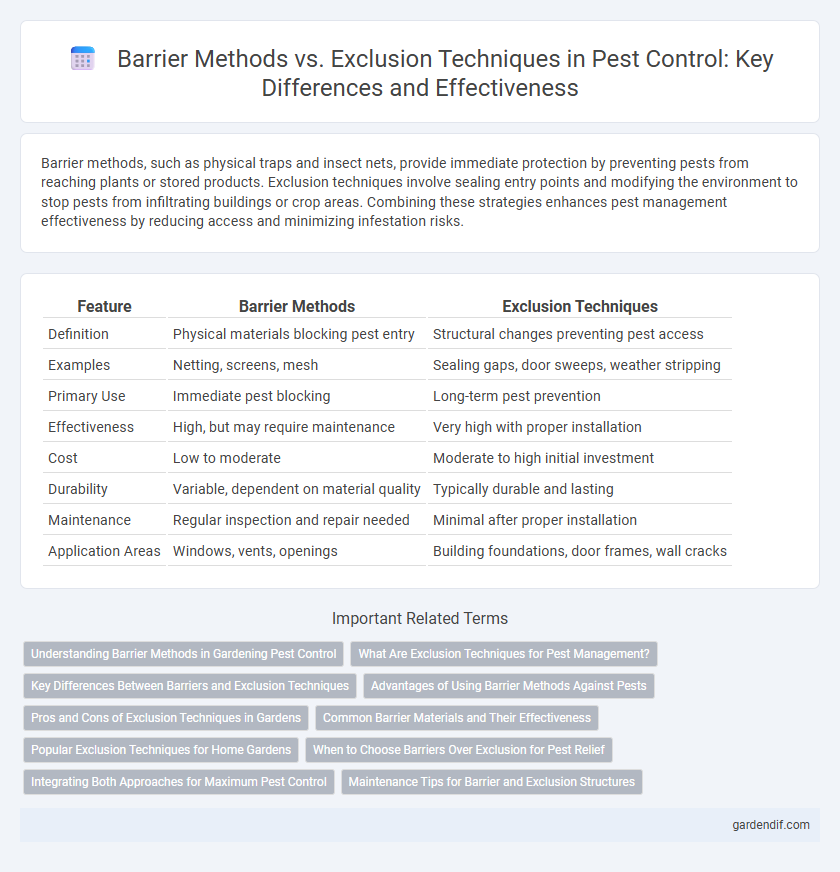
barrier methods vs exclusion techniques Illustration
Barrier methods, such as physical traps and insect nets, provide immediate protection by preventing pests from reaching plants or stored products. Exclusion techniques involve sealing entry points and modifying the environment to stop pests from infiltrating buildings or crop areas. Combining these strategies enhances pest management effectiveness by reducing access and minimizing infestation risks.
Table of Comparison
| Feature | Barrier Methods | Exclusion Techniques |
|---|---|---|
| Definition | Physical materials blocking pest entry | Structural changes preventing pest access |
| Examples | Netting, screens, mesh | Sealing gaps, door sweeps, weather stripping |
| Primary Use | Immediate pest blocking | Long-term pest prevention |
| Effectiveness | High, but may require maintenance | Very high with proper installation |
| Cost | Low to moderate | Moderate to high initial investment |
| Durability | Variable, dependent on material quality | Typically durable and lasting |
| Maintenance | Regular inspection and repair needed | Minimal after proper installation |
| Application Areas | Windows, vents, openings | Building foundations, door frames, wall cracks |
Understanding Barrier Methods in Gardening Pest Control
Barrier methods in gardening pest control involve physical barriers such as row covers, nets, or collars that prevent pests from accessing plants, effectively reducing infestation risk. These methods target specific pests by creating a protective shield, limiting the need for chemical pesticides and promoting eco-friendly pest management. In contrast, exclusion techniques are broader, aiming to seal off entry points or habitats to deter a wider range of pests from the garden environment.
What Are Exclusion Techniques for Pest Management?
Exclusion techniques for pest management involve physically preventing pests from entering or accessing specific areas by using barriers, seals, and screens tailored to block insects, rodents, and other unwanted organisms. These methods reduce reliance on chemical treatments by targeting entry points such as cracks, vents, and openings, enhancing long-term pest control effectiveness. Barrier methods, including door sweeps and mesh screens, serve as practical exclusion tools that create a physical shield against pest intrusion.
Key Differences Between Barriers and Exclusion Techniques
Barrier methods physically block pests by creating a protective shield around plants or entry points, often using materials like mesh, plastic, or fabric. Exclusion techniques involve altering the environment or sealing openings to prevent pests from gaining access, such as caulking cracks or installing door sweeps. While barriers act as direct physical obstructions, exclusion focuses on modifying surroundings to reduce pest entry opportunities.
Advantages of Using Barrier Methods Against Pests
Barrier methods provide a physical shield that effectively prevents pest entry without relying on chemical treatments, reducing health risks and environmental impact. These methods are durable and reusable, offering a long-term, cost-effective solution for pest management in agricultural and residential settings. Their ability to target specific entry points minimizes non-target effects and preserves beneficial insect populations.
Pros and Cons of Exclusion Techniques in Gardens
Exclusion techniques in gardens effectively prevent pest entry by using physical barriers such as netting, row covers, and screens, reducing the need for chemical pesticides and promoting organic gardening. These methods offer long-term pest control with minimal environmental impact but can be costly to install and may limit accessibility to plants for maintenance and harvesting. While providing a protective shield against insects and larger animals, exclusion techniques require regular monitoring and repair to maintain their efficacy and prevent pest intrusions.
Common Barrier Materials and Their Effectiveness
Common barrier materials used in pest control include weatherstripping, mesh screens, and door sweeps, which effectively block entry points for insects and rodents. Metal and stainless steel mesh are highly durable against gnawing pests, while vinyl and rubber barriers provide flexible seals but may degrade faster outdoors. Effectiveness depends on proper installation to cover gaps and weaknesses; combining multiple materials enhances long-term pest exclusion by creating impenetrable physical boundaries.
Popular Exclusion Techniques for Home Gardens
Popular exclusion techniques for home gardens include installing physical barriers such as fine mesh netting, row covers, and garden fabric to prevent pest entry while allowing sunlight and air circulation. Raised garden beds with smooth sides deter burrowing pests, while copper tape effectively repels slugs and snails. These methods reduce chemical pesticide reliance by creating mechanical obstacles that protect plants from common garden pests like aphids, caterpillars, and beetles.
When to Choose Barriers Over Exclusion for Pest Relief
Barrier methods are ideal for immediate pest relief when physical interruption of pest pathways is necessary, such as sealing cracks or installing door sweeps to prevent insect entry. Exclusion techniques, like screening vents or repairing structural damage, are preferred for long-term pest management by eliminating entry points permanently. Choose barrier methods for quick, temporary control and exclusion techniques for sustained prevention and structural pest resistance.
Integrating Both Approaches for Maximum Pest Control
Integrating barrier methods with exclusion techniques enhances pest control efficiency by combining physical obstruction with preventive exclusion, effectively reducing pest entry points and infestations. Utilizing materials such as mesh screens alongside sealing cracks and gaps creates a comprehensive defense that addresses various pest species' behaviors and access methods. This synergistic approach maximizes long-term pest management outcomes by minimizing reliance on chemical treatments and promoting sustainable, eco-friendly solutions.
Maintenance Tips for Barrier and Exclusion Structures
Regular inspections and prompt repairs of cracks, gaps, and worn seals in barrier and exclusion structures enhance pest control effectiveness by preventing entry points. Applying weather-resistant coatings and ensuring materials remain intact during seasonal changes prolongs the durability of these pest barriers. Keeping surrounding vegetation trimmed away from barriers reduces harborage opportunities and maintains clear lines of defense against pests.
barrier methods vs exclusion techniques Infographic

 gardendif.com
gardendif.com